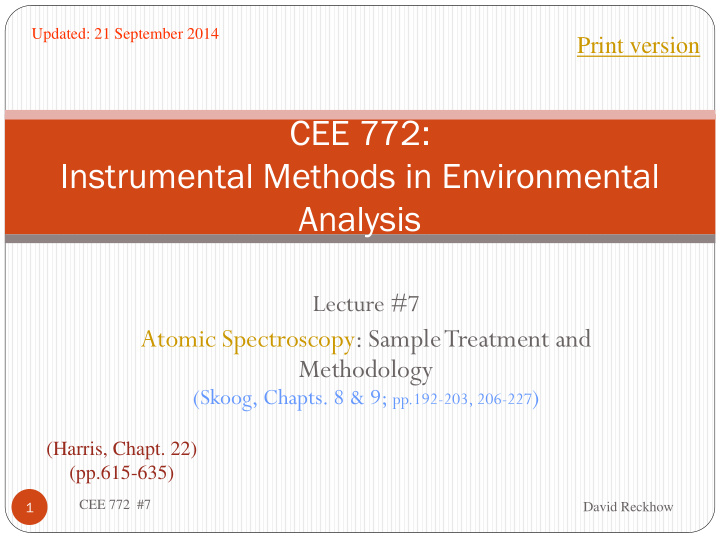



Updated: 21 September 2014 Print version CEE 772: Instrumental Methods in Environmental Analysis Lecture #7 Atomic Spectroscopy: Sample Treatment and Methodology (Skoog, Chapts. 8 & 9; pp.192-203, 206-227 ) (Harris, Chapt. 22) (pp.615-635) 1 CEE 772 #7 David Reckhow
Graphite Furnace 2 CEE 772 #7 David Reckhow
Platform position 3 CEE 772 #7 David Reckhow
Graphite Furnace 4 CEE 772 #7 David Reckhow
Temperature Programming Dry Remove solvent Char Remove organic matter and other volatiles Atomize Convert analyte to an atom vapor 5 CEE 772 #7 David Reckhow
6 CEE 772 #7 David Reckhow
Signals Analysis of Molybdenum A: uncoated tube B: pyro-coated tube 7 CEE 772 #7 David Reckhow
Use of Matrix Modifiers Thermal pretreatment for Cd using different matrix modifiers 8 CEE 772 #7 David Reckhow
Matrix Modifiers, cont. Impact of K on calibration curve for Sr 9 CEE 772 #7 David Reckhow
Thermal Progression 10 CEE 772 #7 David Reckhow
Pretreatment/Atomization 1 Case for Iron Pretreatment Pretreatment First losses just below melting Step point Atomization Probably directly from metal as Atomization many salts decompose at lower Step temps 11 CEE 772 #7 David Reckhow
Pretreatment/Atomization 2 Case for Antimony Pretreatment First losses just below melting point Pretreatment Atomization Step Probably delayed due to high temp of salt Atomization decomposition Step 12 CEE 772 #7 David Reckhow
Standard Addition Use of standard addition to compensate for matrix effects 13 CEE 772 #7 David Reckhow
Photomultiplier 14 CEE 772 #7 David Reckhow
15 CEE 772 #7 David Reckhow
Plasma source The sample is nebulized and entrained in the flow of plasma support gas, which is typically Ar. The plasma torch consists of concentric quartz tubes, with the inner tube containing the sample aerosol and Ar support gas and the outer tube containing an Ar gas flow to cool the tubes (see schematic). A radiofrequency (RF) generator (typically 1-5 kW @ 27 MHz or 41 MHz) produces an oscillating current in an induction coil that wraps around the tubes. The induction coil creates an oscillating magnetic field, which produces an oscillating magnetic field. The magnetic field in turn sets up an oscillating current in the ions and electrons of the support gas. These ions and electrons transfer energy to other atoms in the support gas by collisions to create a very high temperature plasma. 16 CEE 772 #7 David Reckhow
17 CEE 772 #7 David Reckhow
18 CEE 772 #7 David Reckhow
19 CEE 772 #7 David Reckhow
Estimated Detection Element Wavelength (nm) Limit (µg/L) Aluminum 308.215 45 Antimony 206.833 32 Arsenic 193.696 53 Barium 455.403 2 Beryllium 313.042 0.3 Boron 249.773 5 Cadmium 226.502 4 Calcium 317.933 10 Chromium 267.716 7 Cobalt 228.616 7 Copper 324.754 6 Iron 259.940 7 Lead 220.353 42 Magnesium 279.079 30 Manganese 257.610 2 Molybdenum 202.030 8 Nickel 231.604 15 Potassium 766.491 See note c Selenium 196.026 75 Silicon 288.158 58 Silver 328.068 7 Sodium 588.995 29 Thallium 190.864 40 20 CEE 772 #7 David Reckhow Vanadium 292.402 8 Zinc 213.856 2
Atomization and MS 21 CEE 772 #7 David Reckhow
Quadrupole 22 CEE 772 #7 David Reckhow
Plasma MS 23 CEE 772 #7 David Reckhow
24 CEE 772 #7 David Reckhow
ICP-MS 25 CEE 772 #7 David Reckhow
26 CEE 772 #7 David Reckhow
To next lecture 27 CEE 772 #7 David Reckhow
Recommend
More recommend